Exactly What to Do in Lisbon (for First Timers)
In a lot of ways, Lisbon reminds us of San Francisco, which is where we met and spent our first eight years together. It has plenty of hills (which means both incredible views and also getting sweaty trying to get to those views), it has a big red bridge, and it’s earthquake prone. Same-same, but different, right?
One of the first things you’ll learn about Lisbon is that the city was essentially leveled in the middle of the 18th Century, when a huge earthquake (and the subsequent fires) destroyed huge swaths of the city.
That devastating disaster came when Portugal was at the peak of its powers in terms of global influence (many of the world’s preeminent explorers in the Age of Discovery came from Portugal, like Vasco de Gama).
But that fateful day in 1755 changed everything.
What emerged from the ashes of the earthquake is a more modern city (and country, really), which is most evident when you walk through the grid layout of the Baixa neighborhood, which was largely created in the post-earthquake period by Marquis de Pombal.
We could talk for hours fifteen minutes or so about how the earthquake changed Lisbon forever, but the point we’re trying to make here is that Lisbon has been in a constant state of evolution since that devastating moment, and particularly over the past few decades.
In the past five years or so, I swear that Lisbon has popped up on nearly every “up-and-coming travel destinations list.”
As you might imagine, that rapid growth in tourism has led to some new challenges, like a rising cost of living that is pricing out many locals (among other things).
However, rather than resenting tourists who are at least partially responsible for some of those issues, every single Lisbon resident we interacted with, whether it was on a walking tour or at a bar, was warm, friendly, and excited to share their city with us.
Lisbon is now officially on the tourist map, and there is a nearly unlimited number of things to do and see in Portugal’s capital.
From exploring beautiful historic churches and learning about Portuguese history and their contributions to the Age of Maritime Discoveries, to enjoying some of the best seafood and wine in the world, to discovering the sweet-but-sad melody of traditional Fado music, there’s a wide array of attractions and experiences that await you.
In this guide to what to do in Lisbon, we’re not going to give you a list of every single museum, park, square, and church that you could possibly see in Libson.
Instead, we’ll offer you a blend of the main attractions in Lisbon – what they are, some brief historical context, and how to see them – but we’ll also give you some of our other favorite things to do in Lisbon all based on our own personal experiences exploring the city.
Armed with that (and our guide to planning your Lisbon itinerary), you’ll be ready to plan a trip that will go a level deeper than most and learn about the different aspects of Lisbon history and culture that have shaped the city as we know it today.
Learning is our favorite part of travel, which you’ll probably realize as you read this guide.
Sound good to you? Let’s get into it.

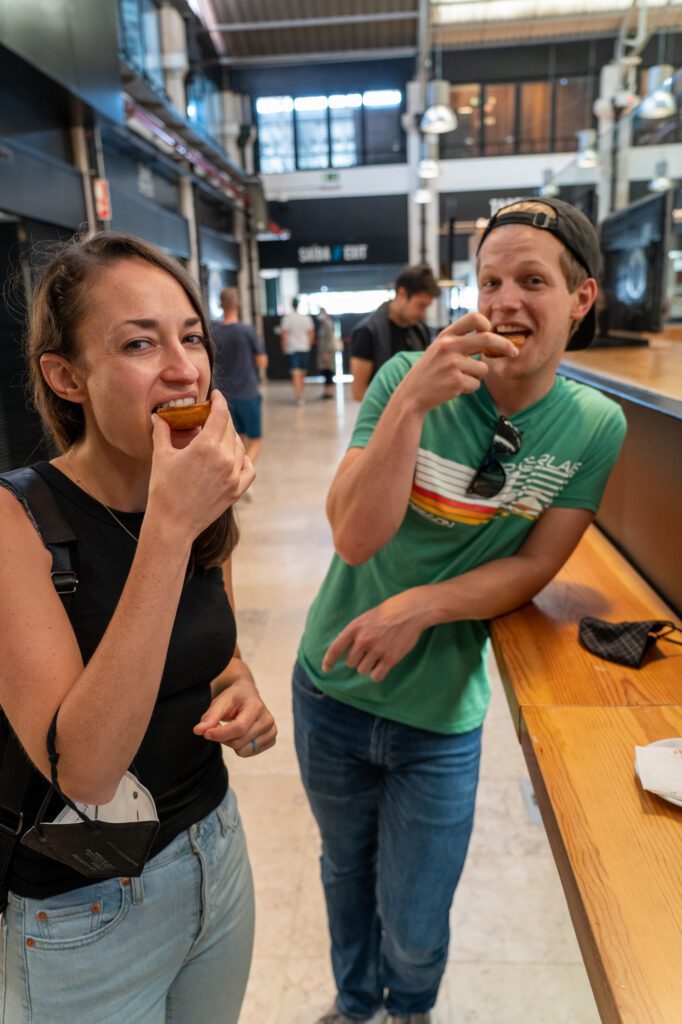
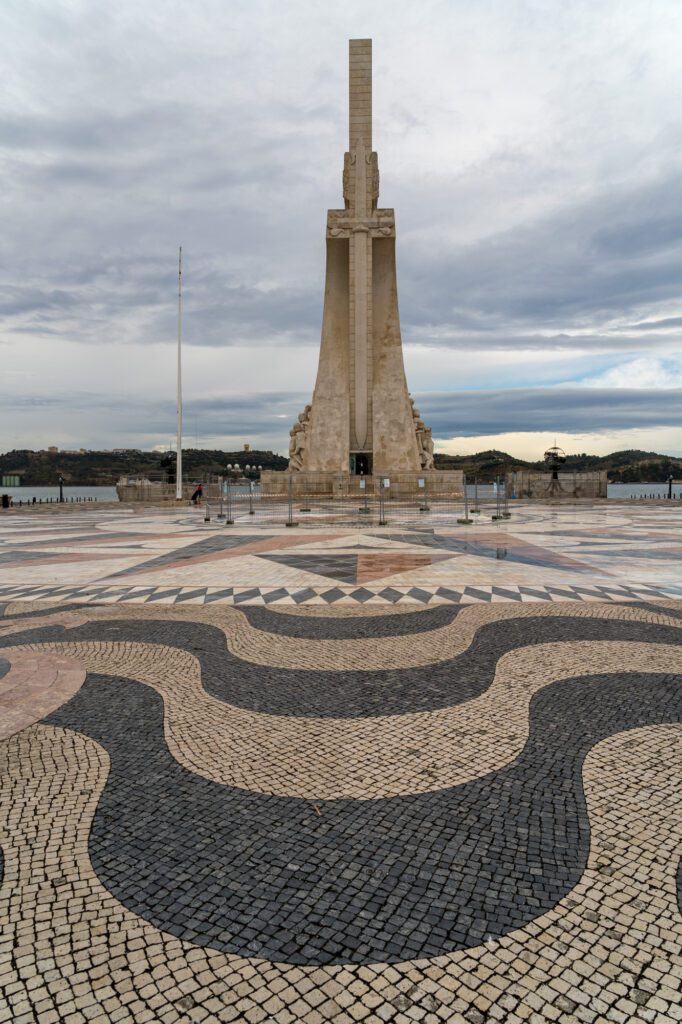
Disclaimer: Some of the links in this post, like hotel links, are affiliate links, meaning at no additional cost to you, we make a little bit of money if you click through and book. That being said, we would never recommend something to you that we don’t stand behind 100%.
What to Do in Lisbon: A Complete Guide for First Timers
And now, let’s get into our favorite things to do and see in Portugal’s capital.
If you haven’t already, make sure to read our guide to planning a perfect 3 day Lisbon itinerary, where we talk through exactly how we’d put this all together to create an unforgettable trip to Lisbon.
Based on our own experience over several visits to Lisbon, below are the top things we think you should do in the city.
Go Deeper with a Lisbon Walking Tour
One of our favorite things to do in any city – including Lisbon – if you want to learn more about the city and its fascinating history is a guided walking tour. A tour is also a great idea if you want to see as much as possible with limited time in the capital.
We enjoyed learning about Lisbon so much that we actually decided to do two separate walking tours on our two visits to the city.
Not only will a walking tour take you to a couple of the best things to see in Lisbon in just a short amount of time, from the most famous landmarks to the city’s hidden gems, but you’ll also have access to a knowledgeable local guide who can answer any question you have and give you some insider tips for visiting the city.
Like, for instance, where to find the best pastel de nata in Lisbon (more on that in a second).
We almost always start our trip to a new city with a walking tour, and think you should too.
Here are a few of the top Lisbon tours we’d recommend:
- Highlights & Hidden Gems of Lisbon. We did this tour on our first day in Lisbon and loved it. It’s a private tour – we had a group of four, so the money worked out – that takes you from one end of the city to the other on foot, with plenty of history and anecdotes along the way. It’s a nice mix of the main sights and some more off-the-beaten-path places.
- We Hate Tourism’s Walk in the Real City. We also did this tour on our latest foray into Lisbon. It’s a cool tour that takes you to parts of the city you’d ordinarily never see on your own as a tourist. We love this tour company as they focus on running responsible and sustainable tours and minimizing the impact that mass tourism has on Portugal (especially in Lisbon).
- LisboaLove Walk. Another great tour for discovering Lisbon’s hidden gems and off-the-beaten-path locations is this alternative Lisbon walking tour with passionate local guide Humberto.
Decide on Your Favorite Pastéis de Nata in Lisbon
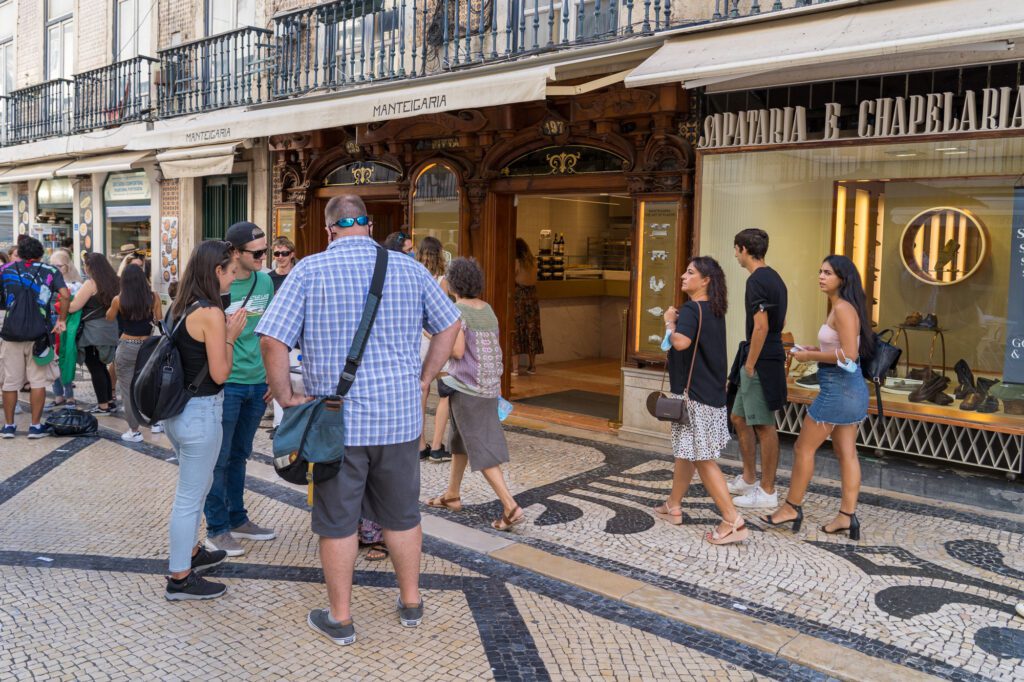
Trying a delicious pastel de nata – the traditional Portuguese egg custard tart – is a must when in Portugal.
And Lisbon is home to some of the best pastelarias (pastry shops) and tastiest pastéis (plural of pastel de nata) in the entire country.
We got three recommendations from locals when we asked about their favorite place to get pastéis de nata in Lisbon. These were:
- Manteigaria. Popular bakery specializing in pastéis de nata, with two outlets in Chiado and Ribeira.
- Pastéis de Belém. The historic bakery in Belém is close to the Jerónimos Monastery where the sweet pastry was invented. This bakery serves the “original recipe” of pastéis de nata (allegedly).
- Pastelaria Aloma. Award-winning pastéis de nata bakery that dates back to 1943, now with multiple locations around Lisbon.
We tried all three to see which version we liked best and Manteigaria was the CLEAR winner.
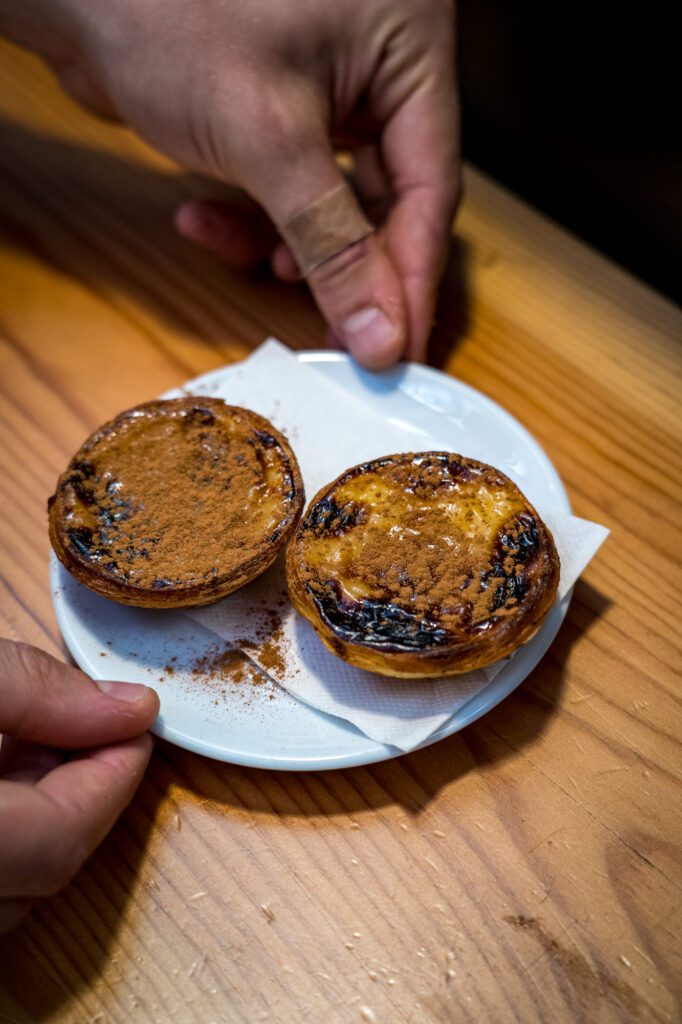
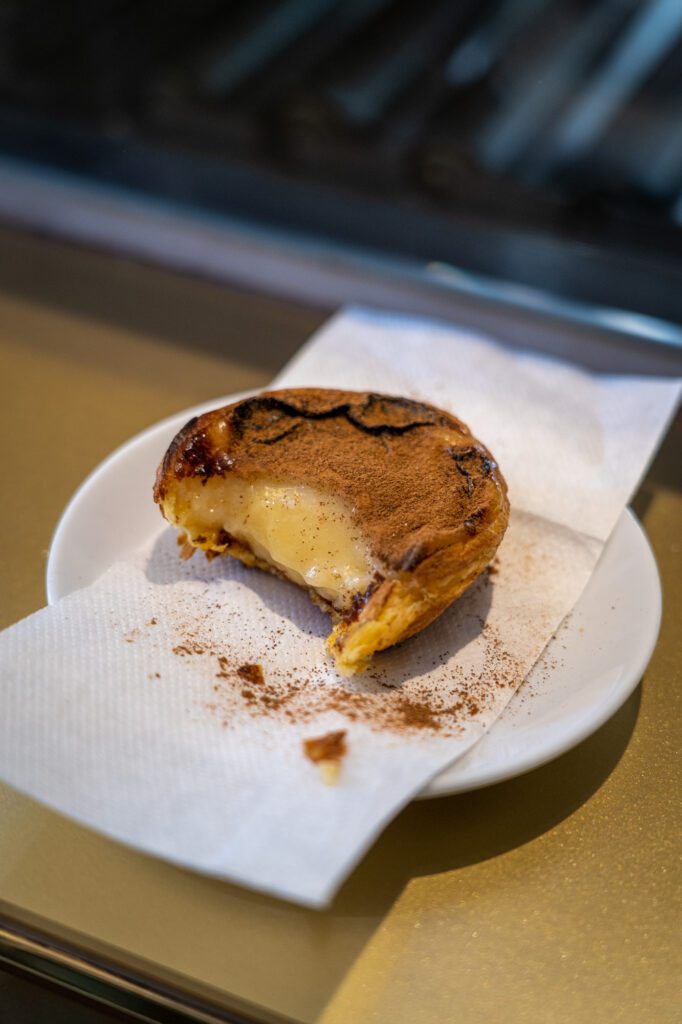
Manteigaria has nailed the crispy shell and the warm, gooey inside with that perfect texture contrast. Their pastéis are best when served warm and dusted with cinnamon.
But don’t just take our word for it. Why not try all three and decide for yourself which is best!
See the Impact of the Earthquake at Convento do Carmo
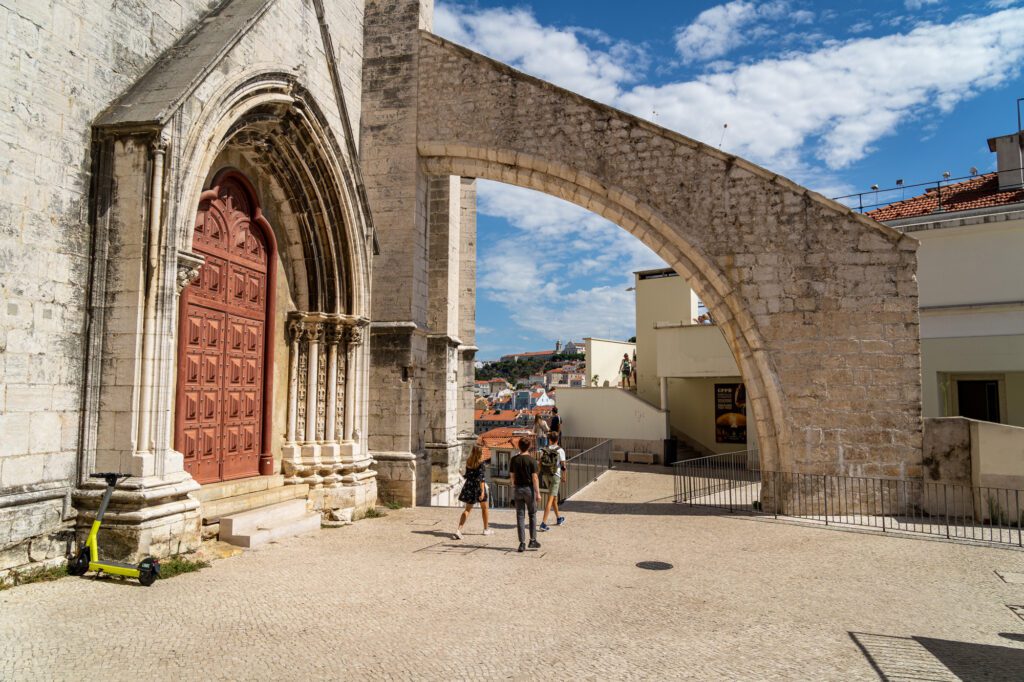
Built in the 14th century, Gothic Convento do Carmo was once one of Lisbon’s most striking churches.
However, the 1755 earthquake caused serious damage and almost completely destroyed the historic building.
Reconstruction of the church was started but never completed, and it was decided to leave the roofless chapel as it was.
The hauntingly beautiful church ruins now sit as a symbol of the devastation caused to the city by the horrifying natural disaster.
Today you can visit the ruins in the Chiado district to see the impact of the infamous earthquake. The building now also houses an interesting archaeological museum, with an eclectic collection of artifacts, tombs, and mummies.
Entry to the church and museum costs €5 per adult and includes a free audio guide. Find out more on their website here.
Learn at One of Lisbon’s Museums
Speaking of museums, Lisbon has plenty of other fascinating museums to explore too. The city’s museums and galleries are great for learning about Portugal’s cultural heritage and seeing some of Lisbon’s most beautiful buildings.
Here are a few museums that are worth your time.
- National Museum of Azulejo. Housed in the former 16th century Convent of Madre de Deus, this unique art museum is dedicated to traditional Portuguese azulejo tiles. At the museum, you can learn about the history and development of the tile, while exploring its spectacular collection spanning over 500 years. Tickets cost €5 per adult.
- Museu Coleção Berardo. A contemporary art museum in Belém, with an impressive collection of modern artwork from artists including Pablo Picasso, Marcel Duchamp, Francis Bacon, and Andy Warhol. The museum is the most visited of its kind in Portugal. Tickets cost €5 but admission is free every Saturday.
- Calouste Gulbenkian Museum. Another of the most famous museums in Lisbon, the Gulbenkian houses one of the world’s most important private art collections. The impressive collection spans 5,000 years of history and was amassed by oil magnate Calouste Gulbenkian during the early 20th century. Tickets cost €10, while admission is free on Sundays after 2:00 pm. Don’t miss the tranquil gardens surrounding the historic building.
Head Out to Belém for an Afternoon

Sitting to the west of the city center, taking a trip out to Belém is one of the most popular things to do in the city. There’s plenty to do in Belém to fill a full day – or an afternoon if you’re short on time.
Once a separate city from Lisbon, Belém dates back to the 1500s – during Portugal’s Age of Discoveries – and is home to many noteworthy historical sites and landmarks.
The Age of Discoveries was a significant historical period of maritime exploration and colonization for Portugal and the rest of Europe.
As the capital expanded, Belém was gradually absorbed and became a district of broader Lisbon.
Despite becoming a part of the capital, the neighborhood has still retained its own unique historical charm (much of central Lisbon is fairly modern, having been rebuilt after the 1755 earthquake).
The entirety of Belém is now even classified as a UNESCO World Heritage Site.
There are four key things we think you should do here, and you can easily walk between them. We’d recommend starting at the furthest end with the Tower of Belém, then working your way back towards Lisbon.
Torre de Belém

Torre de Belém, officially the Tower of Saint Vincent, is a medieval fortification sitting on a small island just off the northern bank of the Tagus River in Belém.
It is one of the most emblematic monuments not only in Belém but in all of Lisbon.
The tower was built in the 16th century for two main reasons; to serve as an entry and exit point for Portuguese explorers coming in and out of Lisbon by ship, and to serve as a coastal defense for the capital.
Today, the tower is a tourist attraction and one of the most popular things to see in Lisbon.
The impressive tower is one of the best examples of Manueline architecture (Portuguese Late Gothic) in the city, with many intricate carvings adorning the structure’s exterior.
Don’t miss the unusual rhinoceros gargoyle, which was the first depiction of a rhino in Europe.
Should you Go Inside the Tower?
We’d say not to bother going inside Torre de Belém. The entrance ticket costs €6 and lines can get super long.
The view from the top isn’t really worth the money or the time it’ll take you to get there. You can see everything you need to from the outside.
Padrão dos Descobrimentos (Monument of the Discoveries)
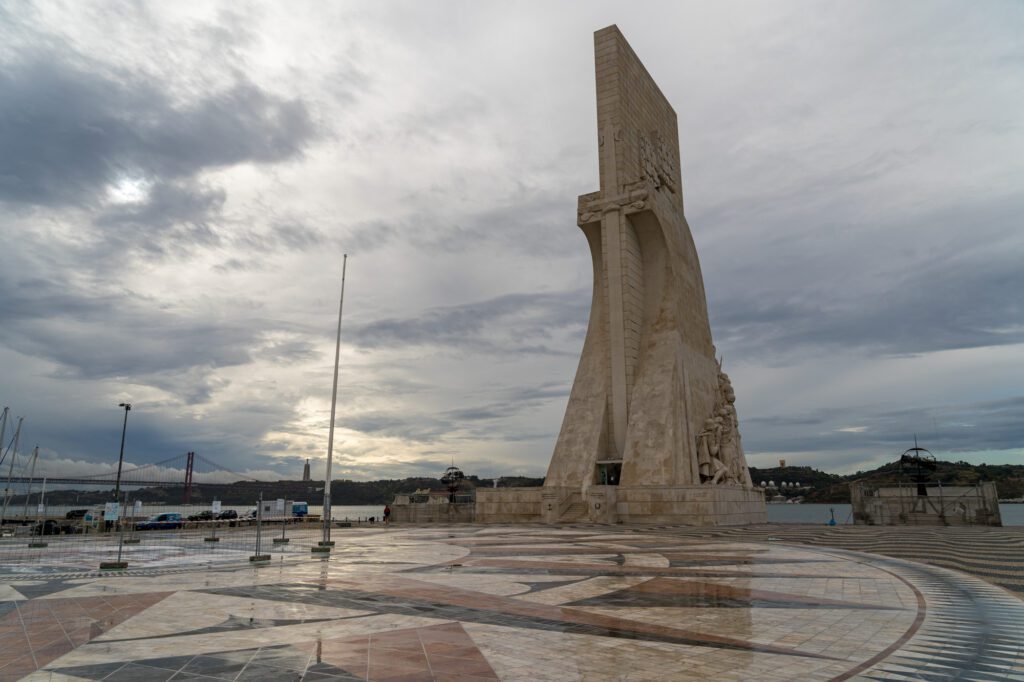
Also sitting along the waterfront is the equally impressive but slightly more modern Padrão dos Descobrimentos, a monument to Portugal’s Age of Discoveries.
The monument was built during the mid-20th century under Portuguese dictator António de Oliveira Salazar, who was known for romanticizing Portuguese colonial history.
The 171 feet tall monument depicts many historically important Portuguese figures from the 15th and 16th centuries.
These sculptures include explorer Vasco da Gama, the first European to reach India by sea, and Pedro Álvares Cabral, who ‘discovered’ Brazil.
You can also head inside Padrão dos Descobrimentos for views from the top. But we don’t think it’s worth it. The monument is best admired from the outside.
The square in front of the monument is also beautiful, with art made from limestone tiles donated by South Africa.
Jerónimos Monastery
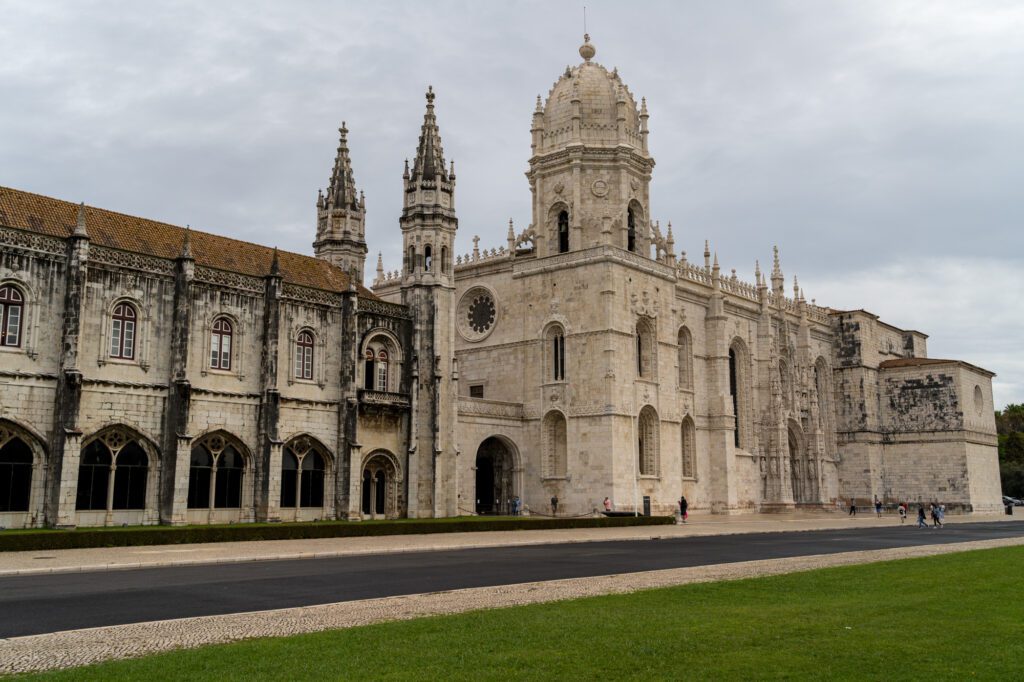
Jerónimos Monastery is the former monastery of the Order of Saint Jerome and is one of the most impressive buildings in Belém.
The construction of the monastery was funded by the wealth of the newly founded spice trade during the 15th century. It took over 100 years to complete.
Much like the Torre de Belém, the monastery is a great example of Lisbon’s typical Manueline architecture.
The grand facade incorporates many maritime symbols, such as ships, shells, and seas, into the Late Gothic style.
It’s free to enter Jerónimos Monastery, so it’s definitely worth taking a look inside.
Although, you do have to pay a €10 entry fee to go into the cloister, which is pretty impressive and worth seeing in our opinion.
Pasteis de Belem
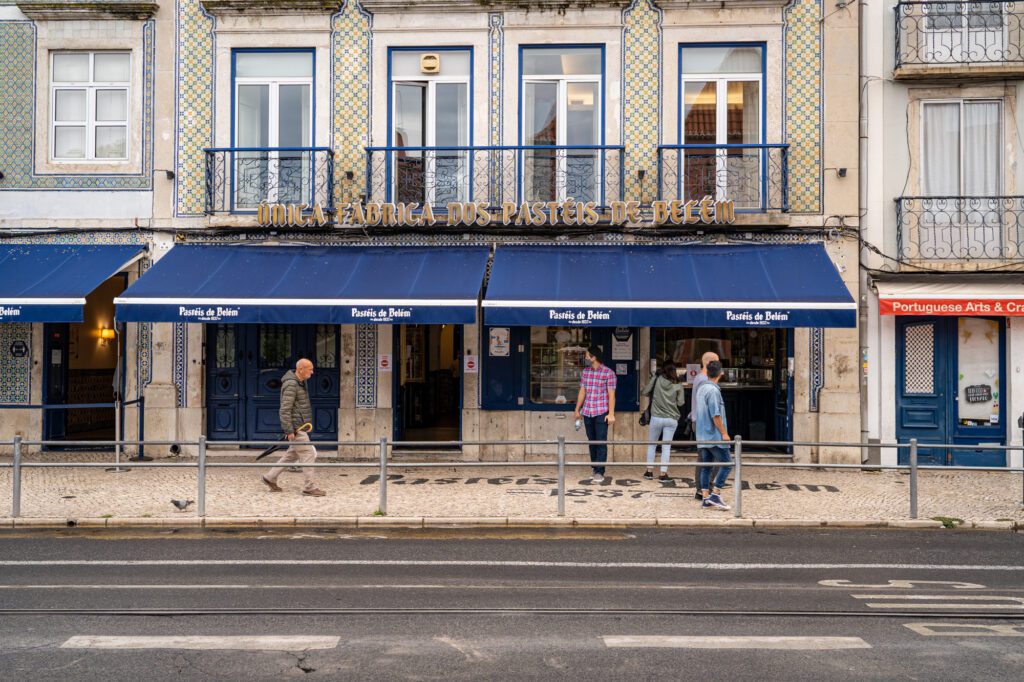
Not far from the monastery, you’ll find another of the most important sites in Belém – the birthplace of the pastel de nata, the traditional Portuguese egg custard tart.
The legend goes that monks from Jerónimos Monastery invented the pastel de nata back in the mid-1800s.
Egg whites were used in the monastery for starching nuns’ robes, which meant there was a ton of egg yolks left over.
The monks began using these yolks to make tasty custard tarts which they’ll sell to their neighbors to make some extra money.
A while later, the monks sold their popular nata recipe to a nearby pastry shop – now called Pastéis de Belém. And this same recipe is still used there today.
The shop is so serious about its brand that only the pastéis de nata that come out of their kitchen can legally be called “Pastéis de Belém” – the original nata.


The pastéis de nata at Pastéis de Belém are claimed by many to be the best in the country. We personally thought the ones at Manteigaria were better, but these came in a close second and are still a must-try when in Lisbon.
How to Get to Belem
The easiest way to get from Lisbon city center to Belém is to take Tram 15E from Praça do Comércio, which is basically a straight shot and takes around 20-30 minutes.
Get off at Largo Da Princesa, start with the Torre, and work your way back towards the city.
Hop back on the 15E when you’re done!
Hang Out at LX Factory
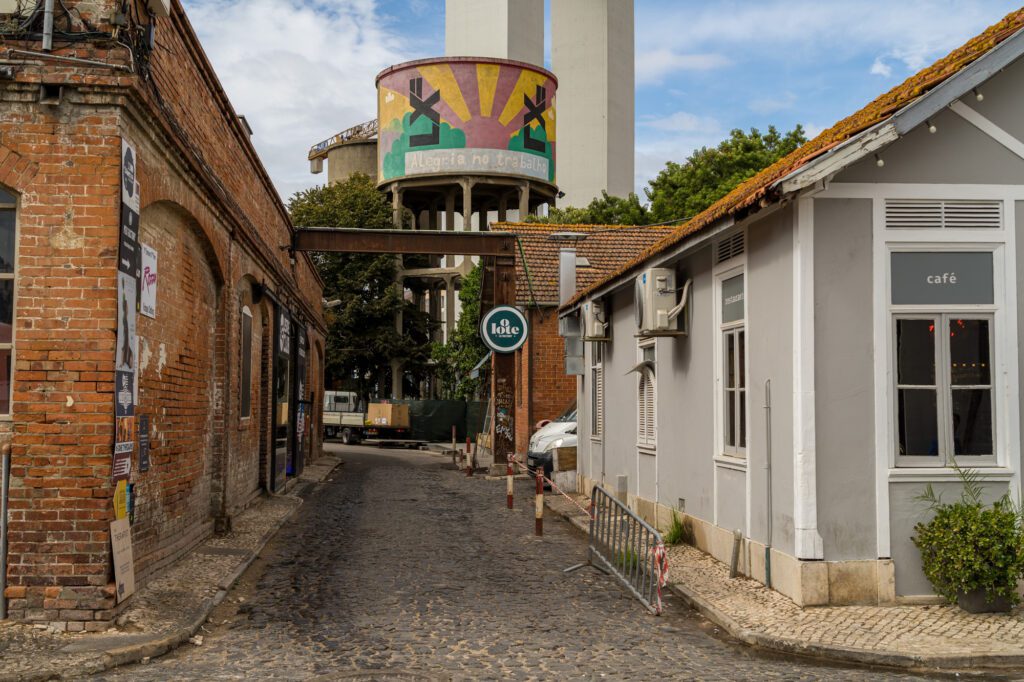
LX Factory is a cool place to visit in Lisbon’s hipster neighborhood of Alcântara.
What was once an important industrial complex is now a large outdoor courtyard filled with an eclectic mix of restaurants, bars, shops, and offices.
The creative hub brings together many local artists, independent artisans, and small businesses, making it a great place to pick up some unique souvenirs and gifts.
Two of our favorite spots at LX Factory are Ler Devagar, a cool bookstore in a former print shop (the printing machines are still there on the top floor), and More Than Wine for great wine and gifts.
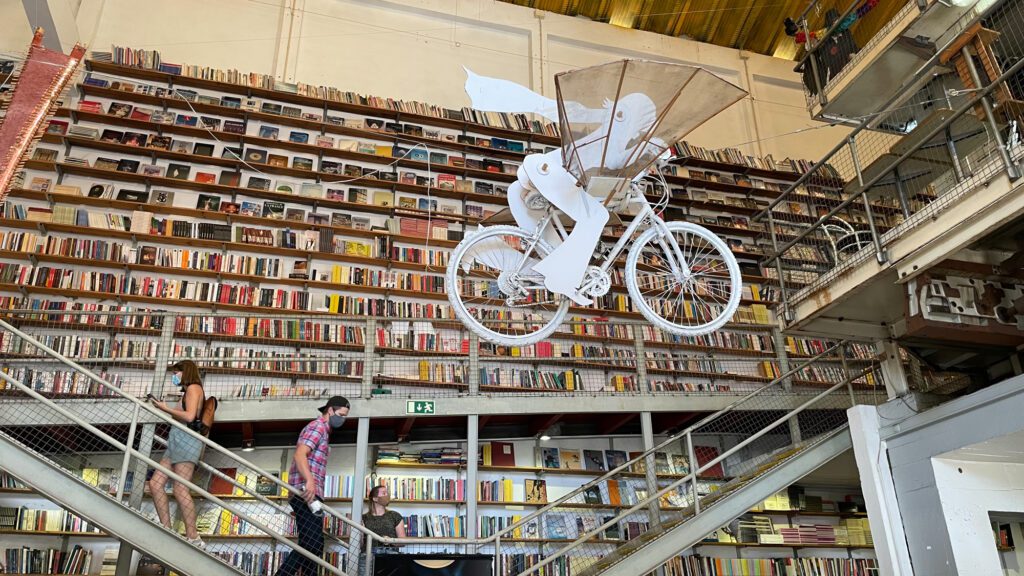
LX Factory is open throughout the day and evening. The daytime is much quieter for some uninterrupted retail therapy.
But the evening is when the complex really comes alive with the buzz of Lisbon’s young, cool crowd filling the uber-trendy restaurants and bars. There’s also a flea market at LX each Sunday.
Alcântara is located to the west of the city close to Belem, so you can easily combine these two stops into one day.
Experience the Best View in the City at Miradouro da Senhora do Monte
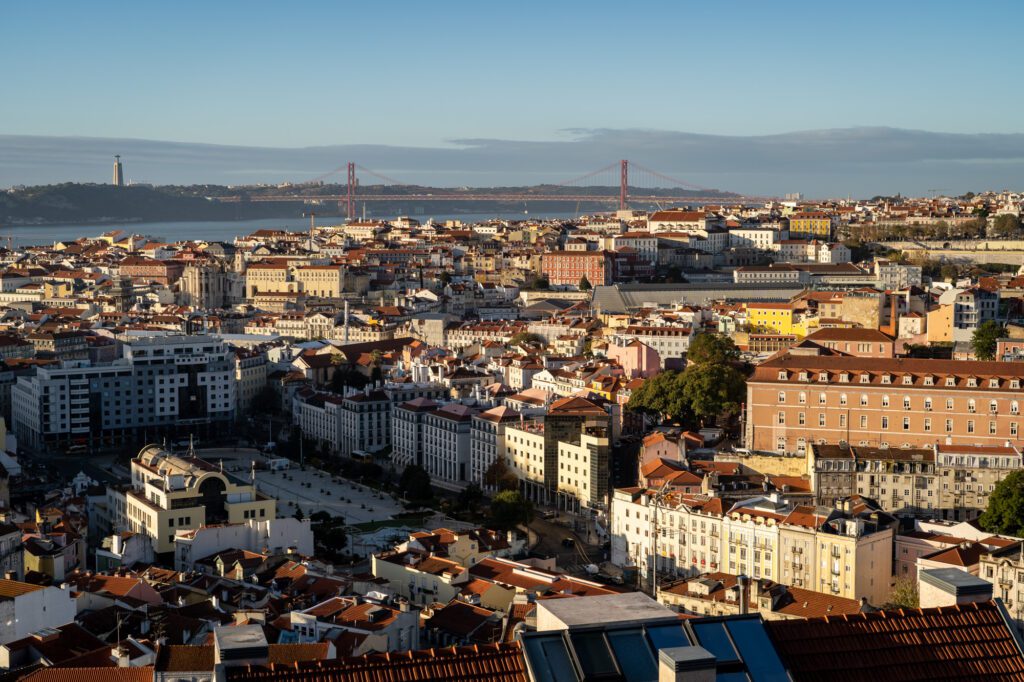
There are so many spectacular viewpoints in Lisbon that it can be difficult to choose which of them to visit.
In our opinion, Miradouro da Senhora do Monte is the one viewing platform that absolutely shouldn’t be missed.
Located in a churchyard, the viewpoint sits in the residential neighborhood of Graça on the tallest hill in Lisbon (did you know that Lisbon is a city of seven hills, much like Rome?).

It’s quite the climb up – you need to keep going uphill from Alfama – but it’s worth the journey for the spectacular views over the city and river from the top.
Dive Into Lisbon’s Food Culture on a Food Tour
There are many things about Lisbon’s food culture that make it special, and it’s well worth your time to spend a few hours learning about it with a local on a Lisbon food tour.
Here are three Lisbon food tours that we’d recommend (we love Airbnb Experiences, as you might have already noticed):
- Portuguese Cuisine Tasting Tour. Learn about the tastes, flavors, cultural influences, and cooking techniques of Lisbon’s culinary scene on this fantastic food tour, which includes 17 food tastings, paired with drinks, in several restaurants and shops run by local families.
- Lisbon’s Best Flavors Tour. This food tour takes you on a journey to discover real Portuguese gastronomy in several family-owned restaurants in Lisbon’s Alfama district. It’s also the first food tour in Lisbon to go completely plastic free.
- The 10 Tastings of Lisbon Private Tour. For a more personal and intimate experience, this half-day tour takes you to sample many Portuguese specialties and traditional drinks with a private local guide. One of the biggest benefits of a private food tour is that it can be tailored to suit your dietary requirements and preferences.
Devour Some Canned Fish at Miss Can
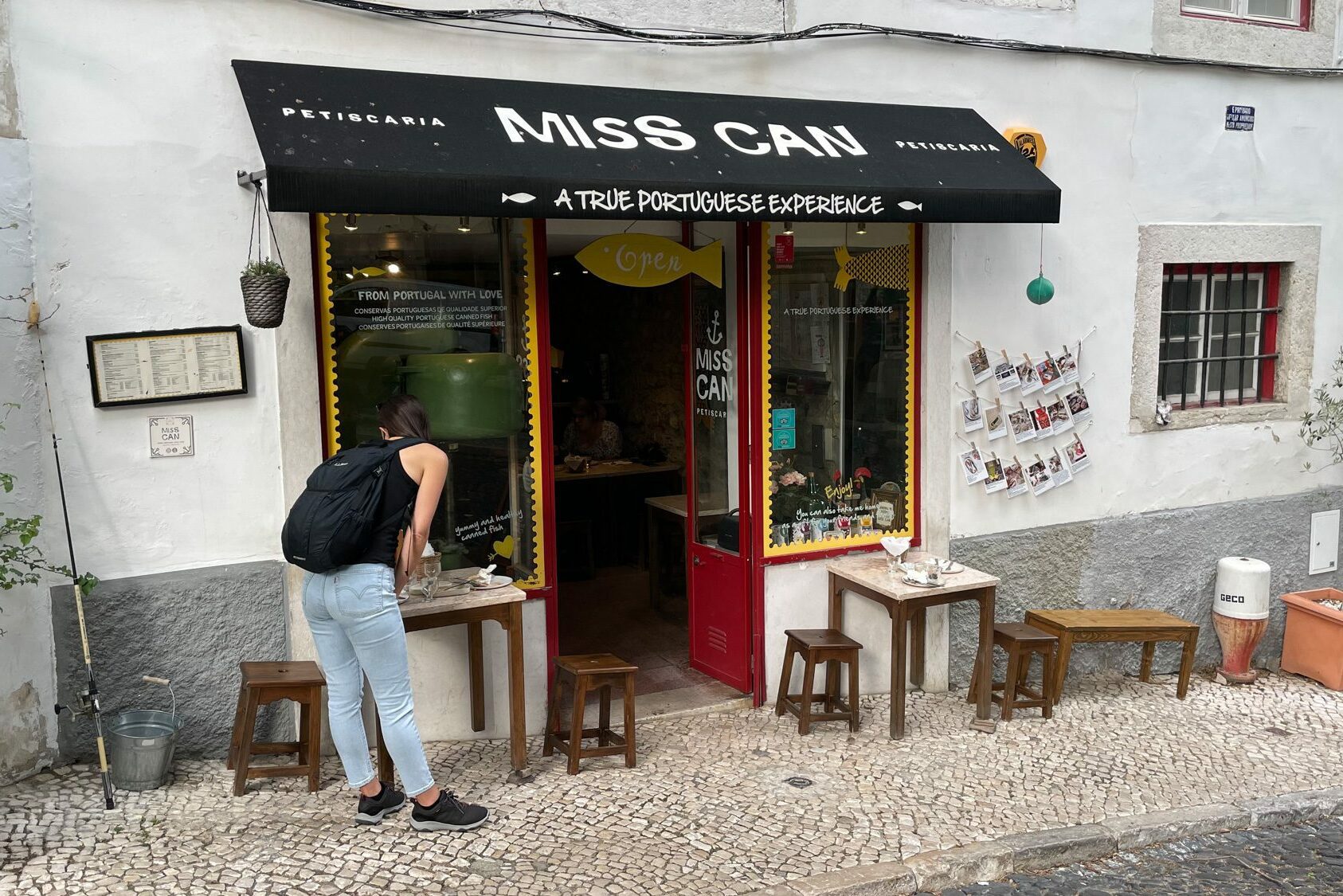
If you’re a foodie in Lisbon, we absolutely wouldn’t miss a visit to Miss Can in the Alfama district.
Miss Can is a family-owned business that has been producing delicious homemade canned fish using wild-caught fresh fish and seafood from Portugal’s seas since 1911.
At the cozy little petiscaria in Alfama, you can sample their tinned fish alongside crunchy bread and a nice list of local wines. And if you like it, you can pick up a few cans to take home with you from the on-site shop.


We LOVED this place and brought back a bunch of fish to share with friends and family. They also LOVED it, and some went as far as to order some for themselves.
Dive Deep into Portuguese Wine
We absolutely loved Portuguese wine. Not only because it’s cheap, but because it also tastes amazing!
Whenever we travel to lesser-known wine-producing countries (Hungary is another good example), we’re always blown away by just how good the wine is. We’re also amazed at how little we hear about it at home in the United States, compared to the bigger producers like France and Italy.
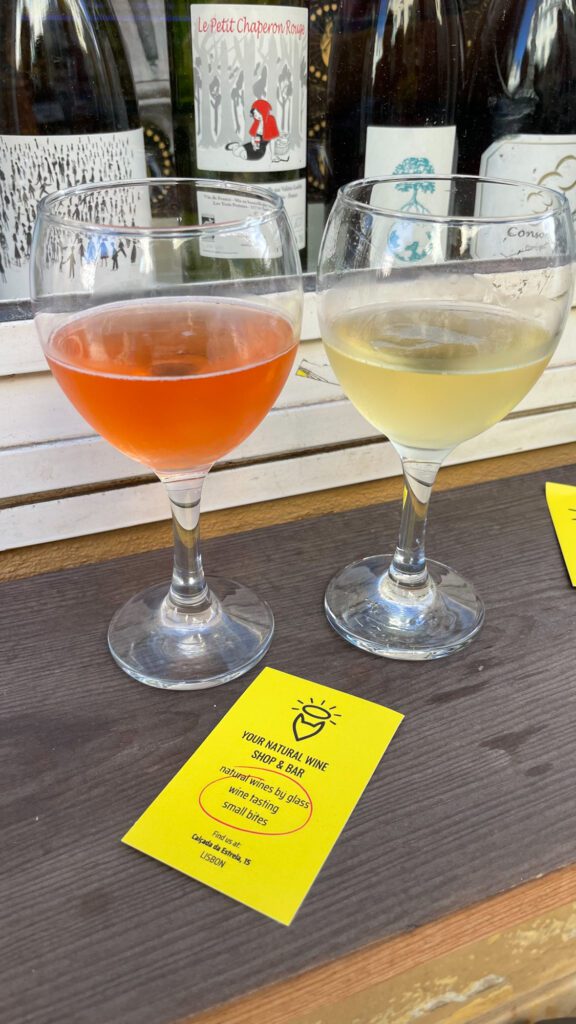

There are some fantastic places to learn about and, of course, sample Portuguese wine in Lisbon. Some of our favorites include:
- Holy Wine. Quite literally a hole in the wall, with a passionate owner who has a bunch of different wines – mostly from Portugal, some from the rest of Europe – that he is eager to share with you.
- Black Sheep. We tried to go here three times and were somewhat thwarted each time for various different crazy circumstances. Finally, on the last try, they were technically closed but were gracious enough to help us pick out a bottle to buy to celebrate our last night in Lisbon (and the conclusion of three months in Europe). The shop has an amazing selection of wines and ciders!
- Senhor Uva. A cozy little wine bar near the beautiful Jardim Guerra Junqueiro. The bar has a great selection of wine and a nice food menu of light bites to go with it.
Try some Local Craft Beer at Oitava Colina (8a Colina)
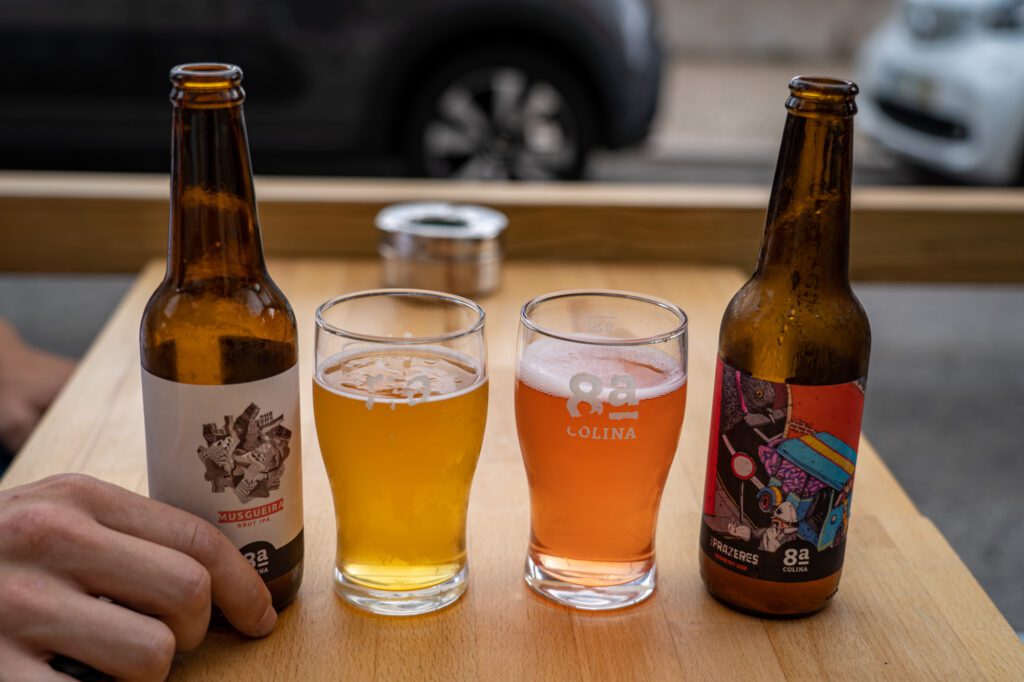
If wine isn’t your thing, you may be happy to hear that Lisbon produces some fantastic local craft beer too.
There are two main beers you’ll find everywhere in Portugal; Sagres and Super Bock, which are both light-bodied pale lagers.
The reason for the limited range of beers in Portugal is at least partially because the market was heavily controlled during Salazar’s regime.
If you’re interested in a deeper look at Portuguese beer, this is a great read.
However, things are beginning to change and the Portuguese beer market has started to open up to competition over the past few decades.
Today, you’ll find a greater range of national and international craft beers appearing in craft beer pubs and bars, particularly in Lisbon and Porto.
Oitava Colina (aka 8a Colina) is one of the best places in Lisbon to try local beer.
The modern brewpub has an excellent selection of craft beers, including porters, stouts, IPA, pilsners, lagers, and more, all brewed right at their on-site brewery.
We stumbled upon this place on a walk up the hill to one of Lisbon’s many amazing viewpoints, and though I can’t drink beer (I have Celiac Disease and gluten makes my intestines hurt), my little brother enjoyed sampling a few of their beers as we sat on the patio with a nice view.
The up-and-coming brand now has two locations in the city; their original taproom 8a Graça, which sits on the top of the hill in Graça overlooking the city, and the newer 8a Fábrica in Cabo Ruivo, close to the river in northeast Lisbon.
Explore Alfama, the Oldest Part of the City
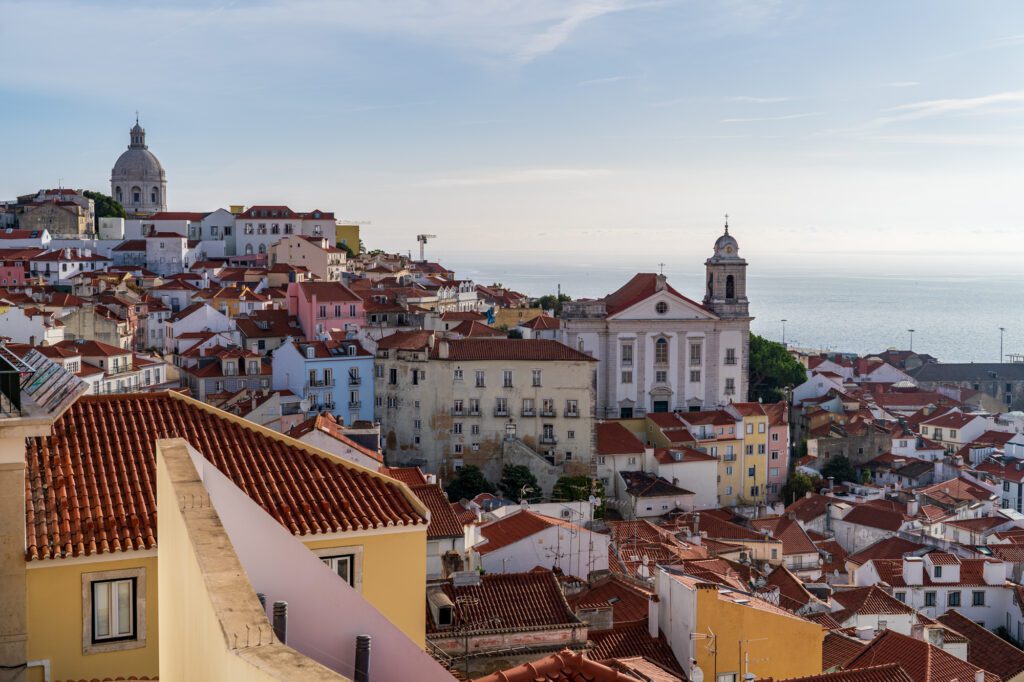
Located uphill from the city center, Alfama is one of Lisbon’s oldest and most charming districts.
The neighborhood is filled with narrow cobblestone streets and amazing vistas over the city.
It is also home to several of Lisbon’s most important historic sites, such as the cathedral and castle.
Taking a leisurely stroll through enchanting Alfama and discovering the area’s many historic landmarks and epic viewpoints is a must-do in Lisbon. Below is a rough route for exploring the best of Alfama.
Note: The below route essentially follows the path of Tram 28 – the one that’s popular with tourists – on foot. We think walking is better than taking the tram (if possible). Tram 28 is a legitimate form of public transportation for locals that has recently been co-opted by tourists for sightseeing.
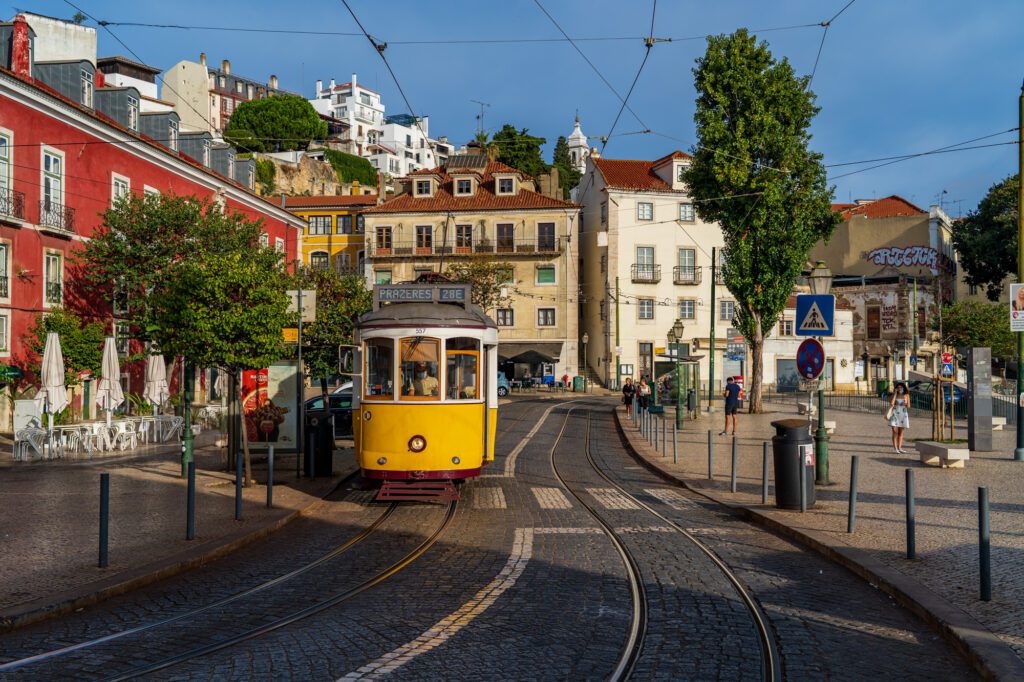
- Start at Lisbon Cathedral at the base of the hill.
- Walk up to Miradouro de Santa Luzia – don’t miss the mural depicting the storming of the castle.
- Take a slight detour up the hill to Miss Can for canned fish and a glass (or three) of wine.
- Grab a drink on the terrace at Miradouro das Portas do Sol.
- Head down a few flights of stairs to check out the History of Lisbon mural.
- Finish with a visit to Castelo de São Jorge.
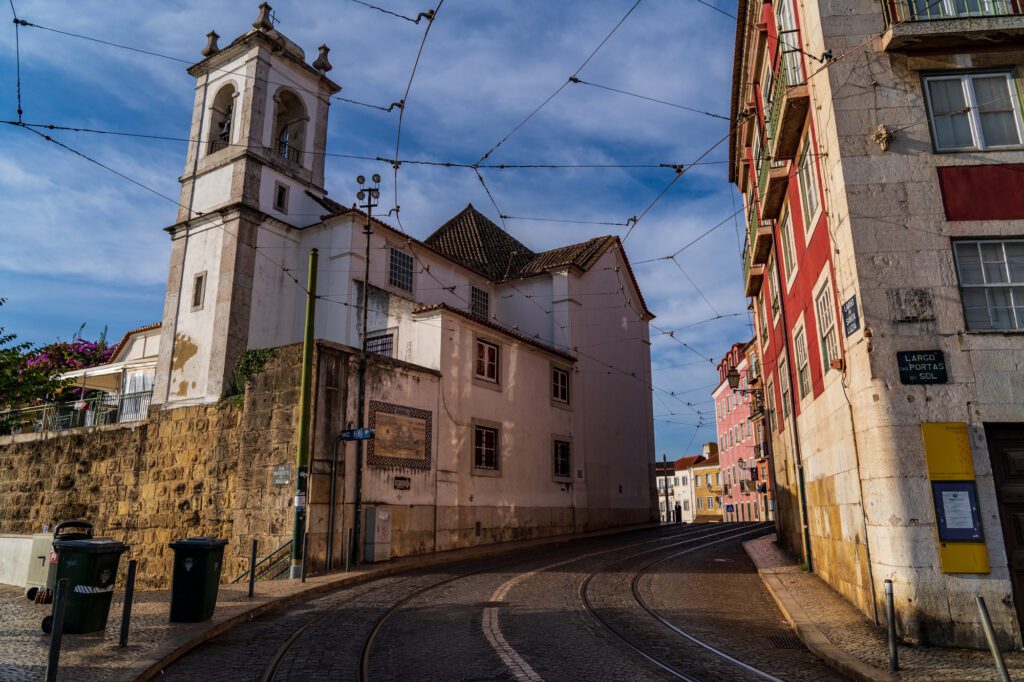
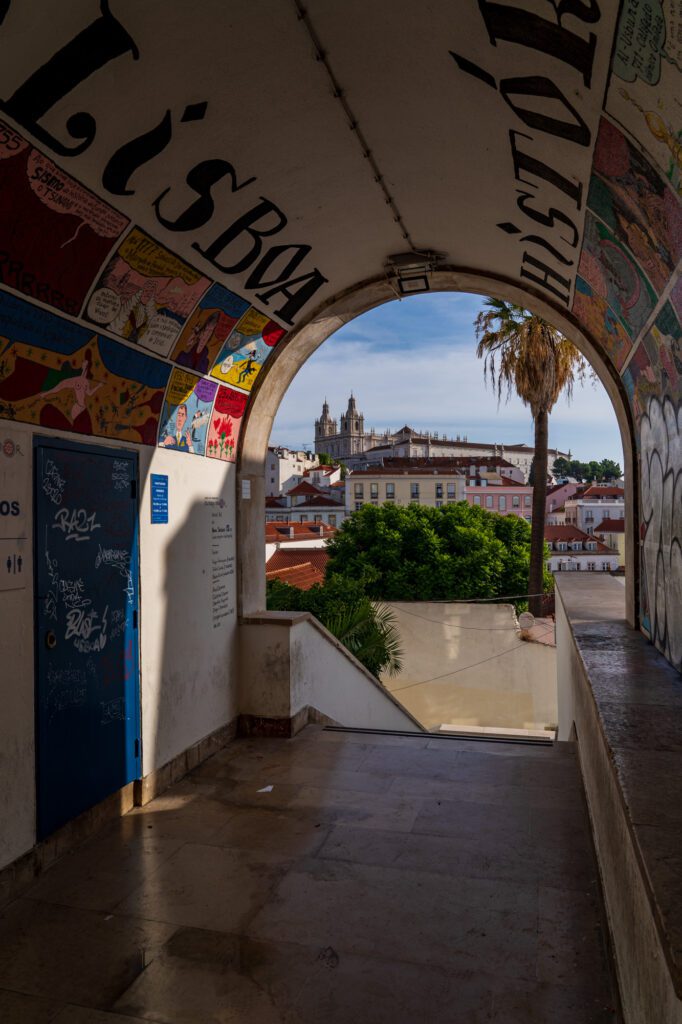
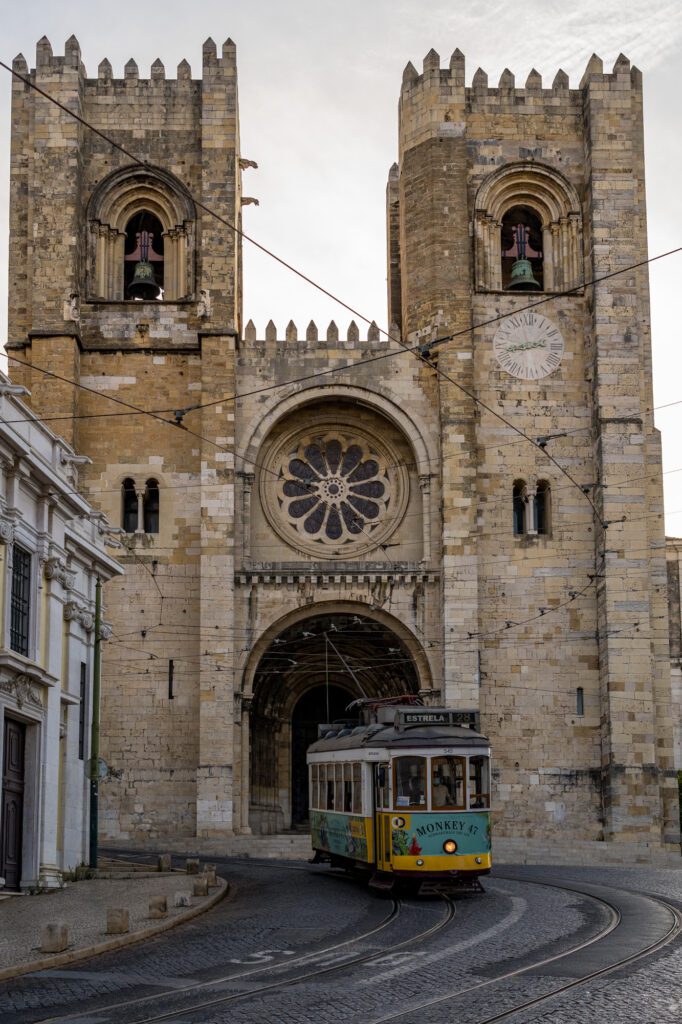
You should know that, while the distance between each destination above isn’t particularly long, it is a steep uphill walk through Alfama to reach the castle. So make sure to take your time, wear sensible walking shoes, and carry some water.
Take the Elevador Da Glória up to Miradouro de São Pedro de Alcântara
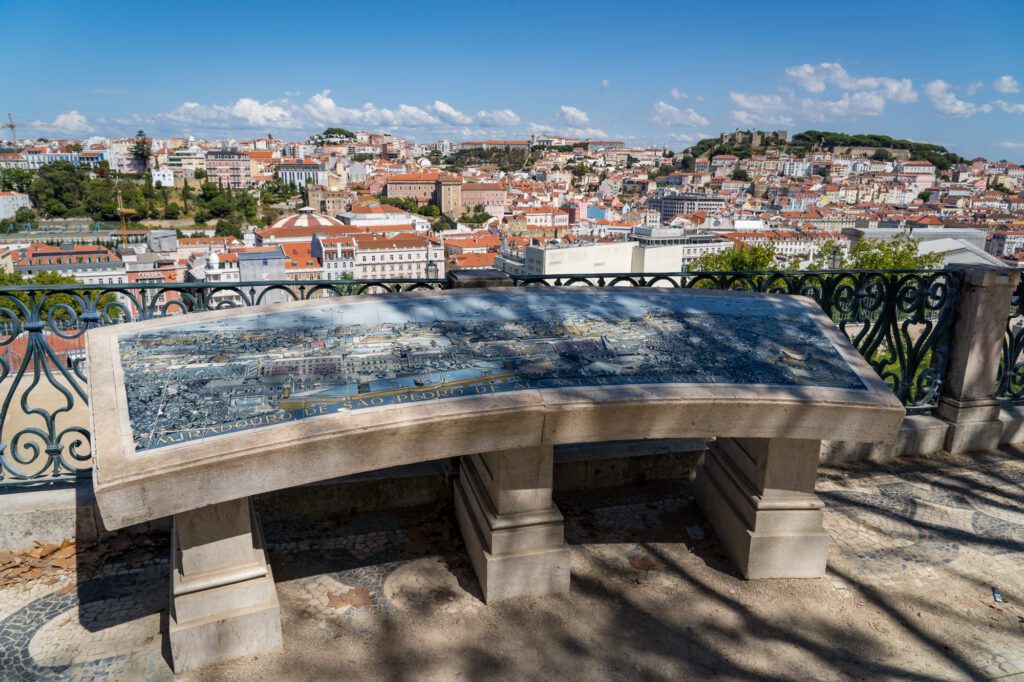
Another fantastic viewpoint in Lisbon can be found at Miradouro de São Pedro de Alcântara. The landscaped terrace has a large fountain and offers stunning panoramic views over the city.
And the great news is that you won’t need to climb yet another steep hill to reach this viewpoint. Instead, you can ride the colorful Elevator Da Glória.
Elevador Da Glória is essentially a short funicular tram that runs up and down the hill between Baixa and hilltop Miradouro de São Pedro de Alcântara.
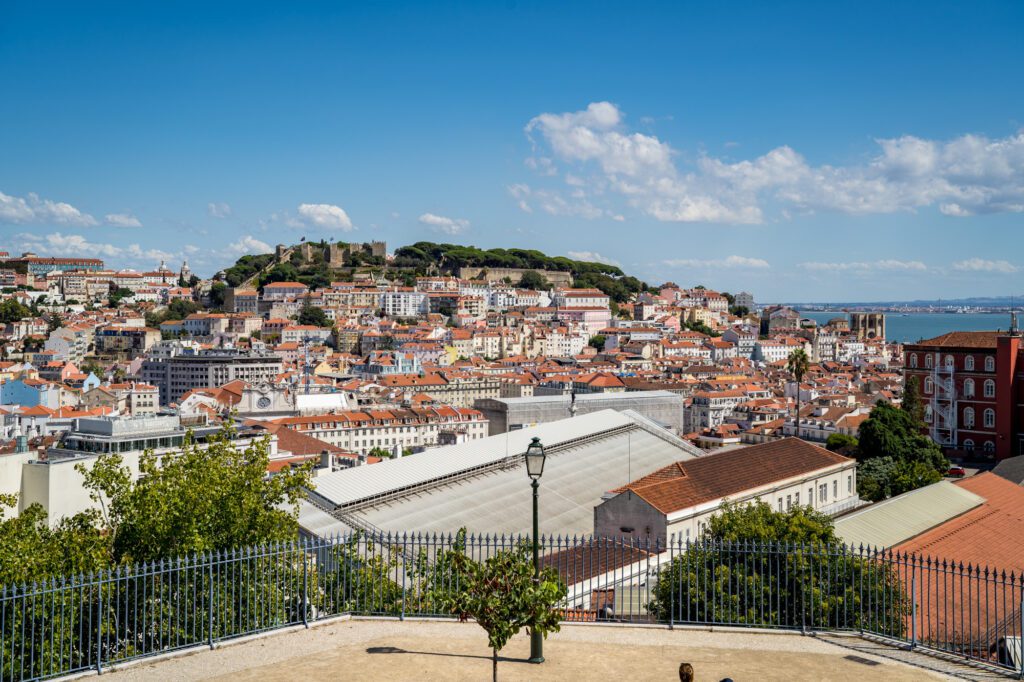
Taking a ride on the unusual ‘elevator’ is one of the most unique things to do in Lisbon, as well as being a convenient and fun way to move around the city.
It’s one of Lisbon’s three elevators, which you can read more about here.
How do you take the elevator in Lisbon? To travel on Lisbon’s elevators, you’ll need a Viva Viagem Travel Card, which you can buy at all Metro stations. Read more in the “Getting Around” section below.
Take a Day Trip to Sintra
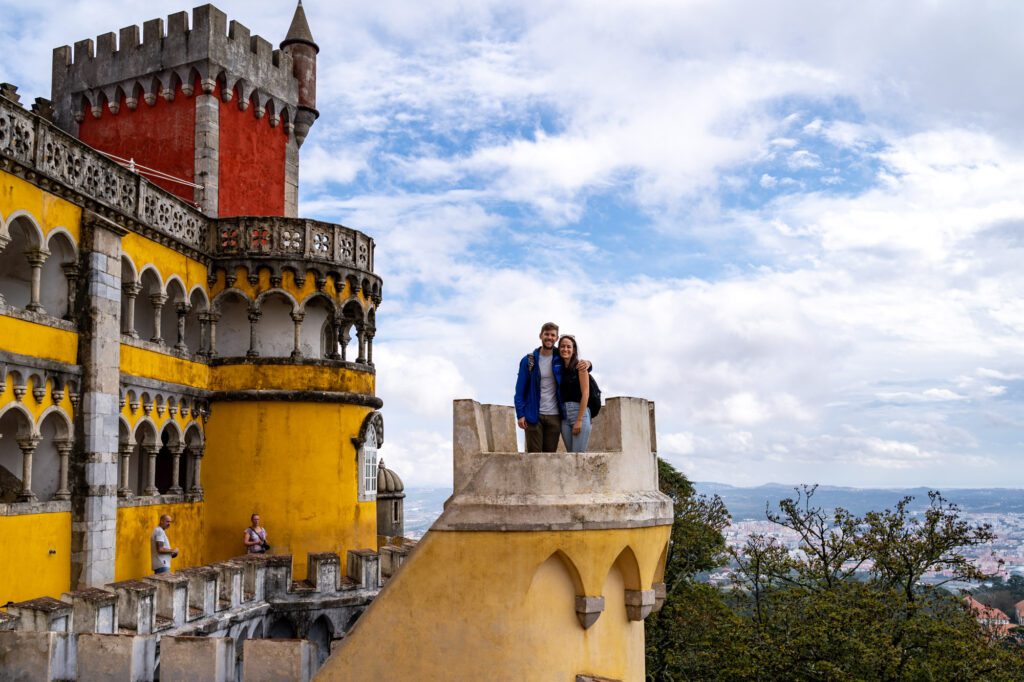
Sintra is one of the most popular day trips from Lisbon and a must-visit if you have the extra time.
Located around 30 km northeast of Lisbon, Sintra is a picturesque hilltop town that was once the preferred summer destination of Portuguese royalty.
The town is home to numerous incredible historic sites built in unique architectural styles that you won’t find elsewhere in Portugal.
There are so many fantastic attractions in Sintra that you won’t be able to fit them all into a single day.
If you are visiting Sintra on a day trip from Lisbon, we’d suggest ticking off Pena Palace and the Moorish Castle. You can also spend some time exploring the town of Sintra itself.
Pena Palace
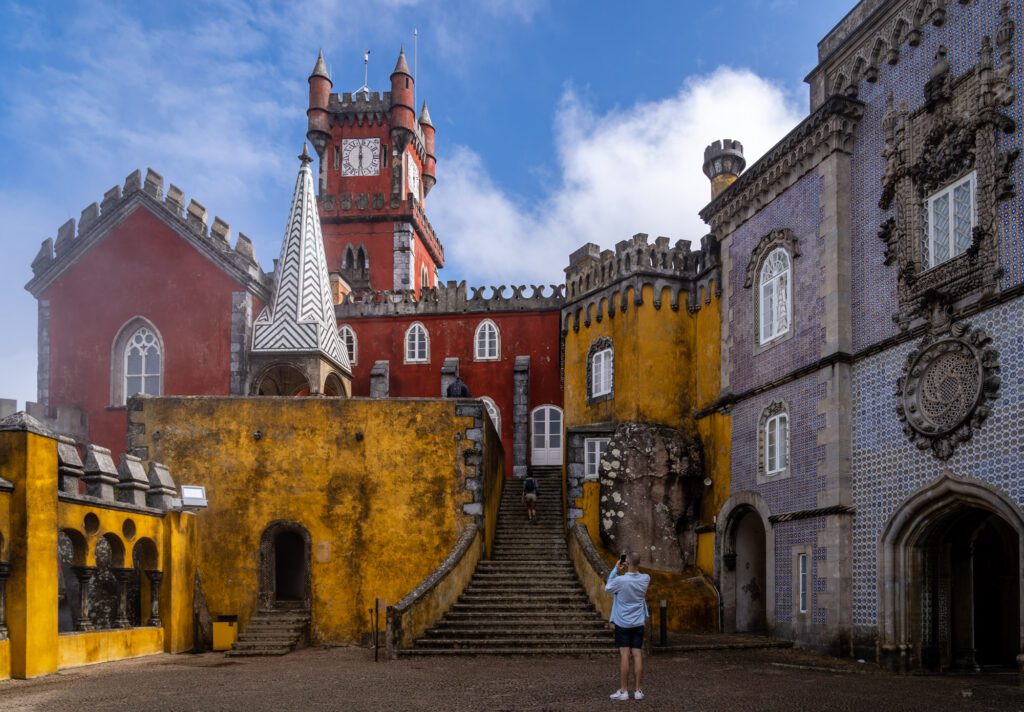
Palacio Nacional da Pena (Pena Palace) is one of the most recognizable landmarks in Sintra, if not the whole of Portugal.
The unusual, brightly colored palace was built as the summer house of King Ferdinand II during the 19th century.
It’s one of the country’s greatest examples of Romanticism, combining Moorish and Manueline architectural styles.
The palace was turned into a museum by the Portuguese government in the early 20th century and was declared a UNESCO World Heritage Site in 1995.
There are two parts of the Pena Palace complex to see; the gardens and the palace interior, both of which require different tickets.
We’d recommend just getting a ticket for the grounds and admiring the palace from the outside. There’s more than enough to explore in the expansive gardens.
Castelo dos Mouros
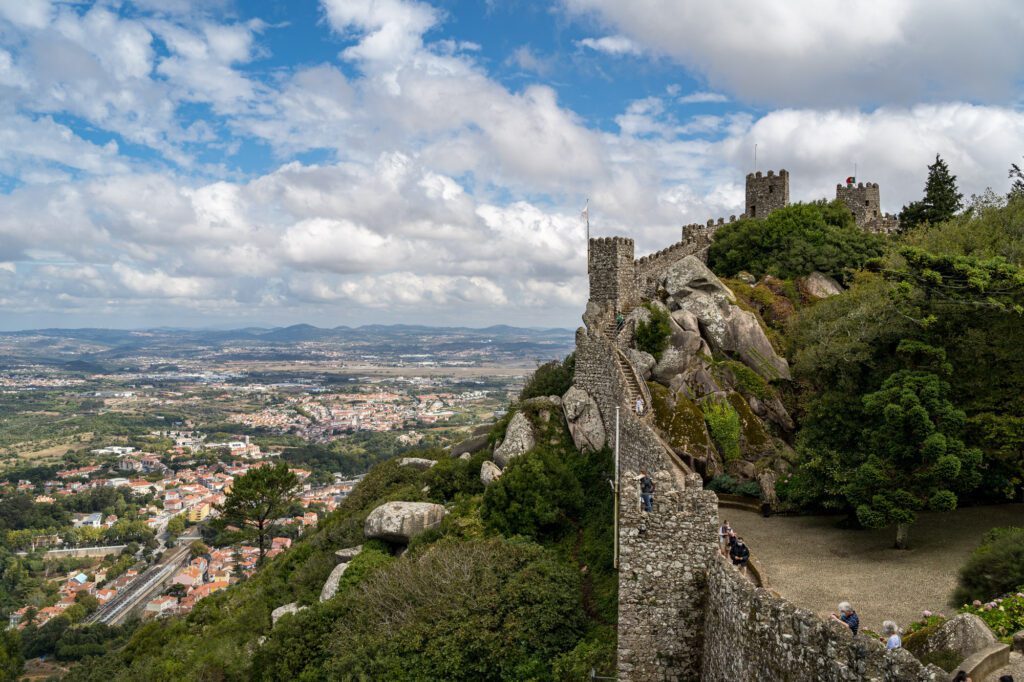
Sintra’s rugged hilltop castle was built in the 8th and 9th centuries by the Moors (Muslims that occupied the Iberian Peninsula at the time, though we probably shouldn’t use the word “Moors” anymore).
It was then restored by King Ferdinand in the 19th century.
The main draw of visiting the historic castle is the amazing views you’ll get over the surrounding region.
You can take a long walk along the reconstructed fortress walls and see out as far as the Atlantic coastline. Don’t forget your camera for this day trip.
How to Get to Sintra
Sintra is easy to reach from central Lisbon by taking a 40 minute train ride from Rossio Station in Baixa.
Make sure to get off at the stop called “Sintra” – NOT “Portela de Sintra” – to arrive close to all the main sites.
Once in Sintra, you’ll want to grab a taxi, bus, or tuk-tuk to get up the hill to Pena Palace to start your day.
Get Caffeinated: Dive into Lisbon’s Thriving Specialty Coffee Scene
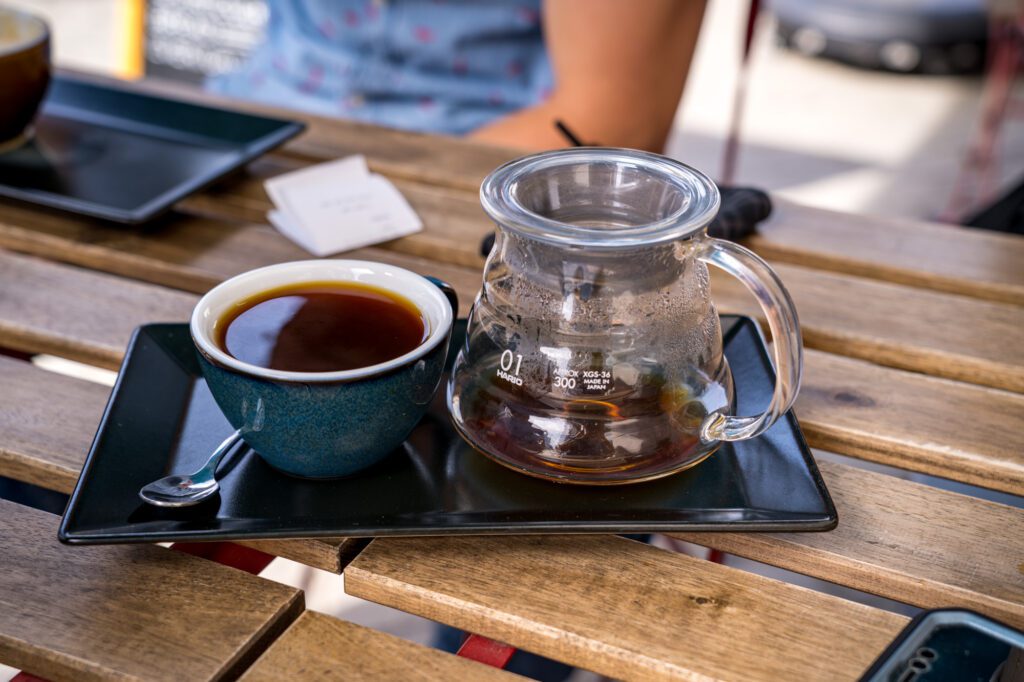
Lisbon is a surprisingly great coffee city. We’re not sure what we were expecting to find, but the city’s thriving specialty coffee scene really blew us away.
It was also great to have an endless supply of caffeine to help fuel us while tackling Lisbon’s many hills.
If you’re a coffee lover too, make sure to check out some of these great spots in Lisbon. You can also check out our full guide to the best specialty coffee in Lisbon here.
- Bloom Coffee Room (temporarily operating out of the Folks). A specialty coffee curator with an extensive range of coffees from European roasters all prepared meticulously. This was one of our absolute favorite spots for coffee in Lisbon.
- Fábrica Coffee Roasters. A fantastic option for consistently great coffee, with multiple locations across the city. Get the AeroPress, which is brewed using the AeroPress World Championships winning recipe.
- Buna Specialty Coffee Shop. Another great coffee curator in Lisbon. They rotate through various roasters from around Europe, and had coffee from both Ireland and Sweden when we were there. They also have a great location on a sunny corner in one of Lisbon’s coolest neighborhoods.

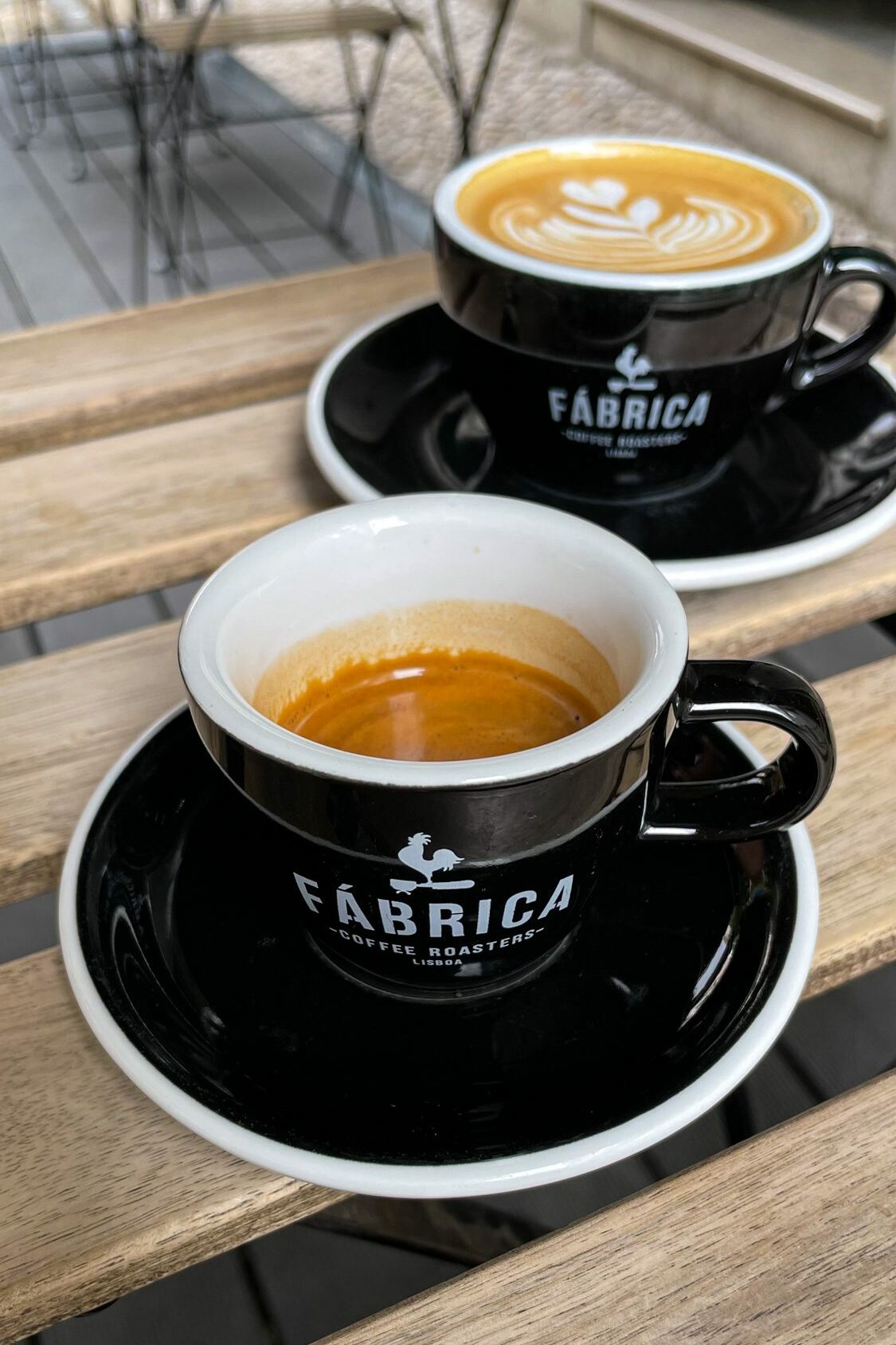
Experience an Evening of Fado
For a truly authentic Lisbon experience, spend an evening sipping on Portuguese wine and listening to the melodic tunes of local Fado music.
Fado is a musical genre that originated in Lisbon in the early 1800s. The unique style features melancholic singing and traditional string instruments. It’s characterized by its soulful tunes and sad lyrics.
There are many places in Lisbon to hear live Fado music, from traditional Fado houses such as Mesa de Frades and Casa de Fados, to modern bars and restaurants with Fado performances each evening.
You can also attend a Fado concert, but we think enjoying the relaxing music over dinner and drinks is the best (and most authentic) way to experience it.
At some of the more popular Fado houses and restaurants, you’ll need to make a table reservation in advance.
Or you can simply take a stroll through the streets of Alfama or Bairro Alto during the early evening. You’re sure to stumble across somewhere with a live Fado performance taking place that night.
Walk the Walls at the Castelo de São Jorge
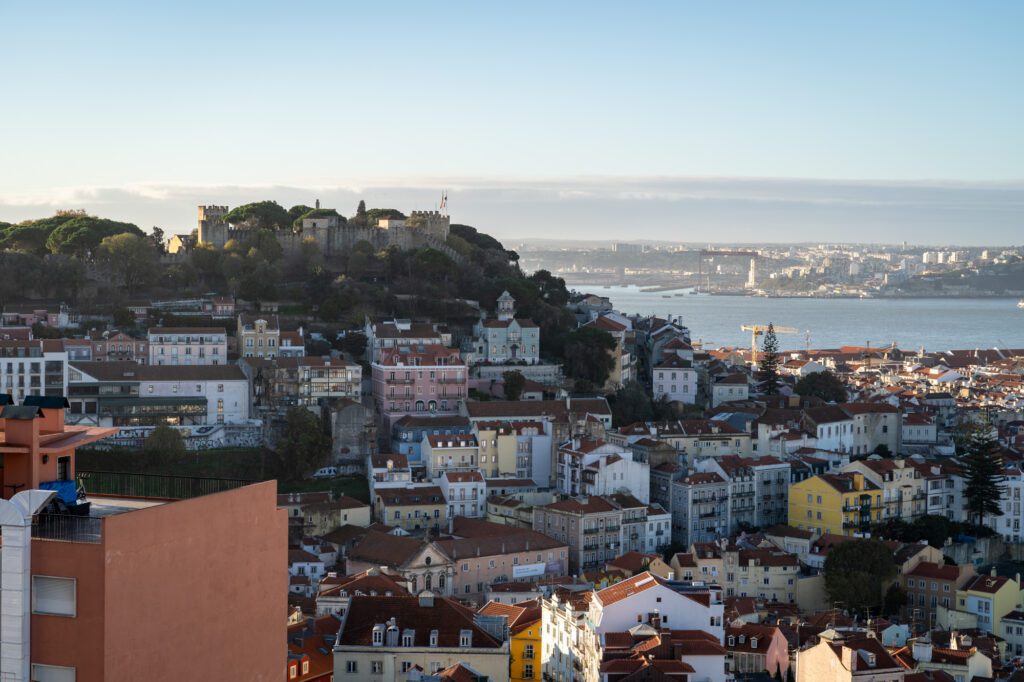
Sitting on a hilltop in the Alfama district, Castelo de São Jorge is Lisbon’s impressive 11th century Moorish castle.
The castle started its life as a defensive fortress to help protect the city from invaders. It’s also been used as a royal palace, military barracks, hospital, and prison over the years.
In the 20th century, the castle underwent a huge renovation project to bring it back to its former glory.
While there’s not much to see inside the castle itself these days, the fortress walls boast fantastic panoramic views over the entire city, which are more than worth the €10 entry price alone.
You can also visit the camera obscura and explore the many hidden pathways winding through the castle grounds.
Take the Ferry Over to Cacilhas
Located on the opposite bank of the River Tagus from Lisbon, Cacilhas is a charming little town that’s famous for its fresh fish.
It’s a great place to escape the busy city center for a relaxing waterfront stroll and a tasty seafood lunch.
Below are some of the best things to do in Cacilhas:
Cacilhas Waterfront
Taking a slow walk along the scenic Cacilhas waterfront is one of the best things to do in the district. From the riverside footpath, you’ll be treated to amazing views back over the Lisbon skyline and the iconic 25th of April Bridge.
Many of the buildings along the waterfront are abandoned and dilapidated, so we wouldn’t advise getting too close or trying to go inside them. However, the colorful graffiti covering the facades is pretty cool to check out.
Fresh Fish Lunch at Ponto Final
At the end of the riverfront promenade, you’ll find a handful of cafes and restaurants. The most famous of these is Ponto Final, where we’d recommend stopping for a waterfront lunch.
We discovered Ponto Final in an episode of Somebody Feed Phil – our favorite food show in the world – and have had it on our list ever since (though we only learned about it AFTER our time in Lisbon, unfortunately).
The rustic restaurant has a large terrace overlooking the water and is famous for its delicious local fish and seafood dishes.
It is pretty popular though, so you may want to book a table in advance to avoid disappointment.
Prices at Ponto Final are also a little more expensive than elsewhere in the district.
For a cheaper place to sample Cacilhas’s famous fresh fish, head to one of the restaurants or local pubs on Rua Cândido dos Reis close to the ferry port.
Santuário de Cristo Rei
Santuário de Cristo Rei – or Sanctuary to Christ the King – is a large Catholic statue in Cacilhas, dedicated to the Sacred Heart of Jesus Christ. If the statue looks familiar to you, that’s probably because it was inspired by Rio’s famous Christ the Redeemer.
The statue is not only a place of worship and a popular pilgrimage site, but it also has a viewing platform at the top for tourists, with spectacular views over Lisbon.
You’ll need to pay €6 to visit, but there is a lift that will take you almost to the top. The statue is around a 45 minute walk from the ferry terminal.
How to Get to Cacilhas
Cacilhas is located in the city of Almada, sitting just across the river from Lisbon.
It can be reached from Lisbon by taking a direct 10 minute ferry which departs regularly from Cais do Sodré and costs just €1.30 per journey. You’ll need to use your Viva Viagem Card to travel on the ferry.
Hit the Beach in Cascais
Sitting around 30 km west of the capital, Cascais is a lovely coastal resort town with multiple beautiful beaches, a marina, a small harbor, and several scenic walking routes.
It makes the perfect day trip from Lisbon on a hot summer day.
There are tons of beautiful beaches in Cascais to choose from:
- Praia da Conceição & Praia da Duquesa. These two large connecting beaches make up the longest stretch of sandy coastline in Cascais. The beautiful beaches have plenty of facilities, including sunbed and parasol hire, beachside bars and restaurants, and plenty of water sports. The calm waters are great for children. Conceição is also the closest beach to Cascais train station, making it a good choice for a Lisbon day trip.
- Praia da Ribeira & Praia da Rainha. Located in Cascais town center, these two small, idyllic beaches are nestled underneath rocky outcrops and overlook the historic fishing harbor. While convenient for combining with a visit to the town itself, the beaches are overlooked by the beachfront promenade, so don’t expect much privacy.
How to Get to Cascais
There’s a direct train that connects Lisbon’s Cais do Sodré Station with Cascais on a line called the ‘Linha de Cascais’. The train journey takes around 40 minutes and costs €2.25 on your Viva Viagem Travel Card.
Visit São Vicente de Fora Monastery and Church
São Vicente de Fora monastery and its connecting church are two of Lisbon’s most important and most impressive historical buildings.
The huge monastery was constructed in the 17th century on the site of a much older church.
The original church was built in the 12th century, under the reign of King Afonso Henriques, after the Christian reconquest of the city. It was dedicated to St. Vincent, the patron saint of Lisbon.
Mosteiro de São Vicente de Fora translates to “Monastery of St. Vincent Outside the Walls”, referring to the fact the historic church was originally built outside of Lisbon’s city walls.
Today, it is located in the heart of the Alfama district, overlooking the rest of the city from its hilltop location.
The church is free to enter, but you need to pay €5 to visit the richly-decorated monastery buildings.
The monastery is now home to a large museum, with an extensive collection of paintings, sculptures, clothing, and more spanning several hundred years of Lisbon’s history.
It’s definitely worth paying the entrance fee to explore the exquisite building.
Don’t miss the world’s most extensive collection of baroque azulejo tiles in the monastery’s cloisters or the amazing views over Lisbon from its towers.
Planning a trip to Portugal?
Here are our other Portugal travel guides to help you plan an incredible trip (even if you have to eat gluten free!).
If there’s no link below, it means we’re still working on it – long, in-depth guides take time! We’re working on it, though, we promise.
Portugal:
- Exactly How to Spend One Week in Portugal (for First Timers)
- 10 Days in Portugal: Planning the Perfect Portugal Itinerary
Lisbon
- 25 Incredible Things to Do in Lisbon: A Complete Guide
- 3 Days in Lisbon: Planning the Perfect Lisbon Itinerary
- One Day in Lisbon: The Best of Lisbon in 24 Hours
- Where to Stay in Lisbon: Our Guide to 4 Amazing Places to Stay
- Gluten Free Lisbon: A Complete Guide to Lisbon’s Best Gluten Free Restaurants
- The Best Coffee in Lisbon: 9 Amazing Lisbon Coffee Shops to Add to Your List
Porto:
- 3 Days in Porto: Planning the Perfect Porto Itinerary
- One Day in Porto: How to See the Best of Porto in a Day
- Where to Stay in Porto, Portugal: The 3 Best Places to Stay
The Algarve:
